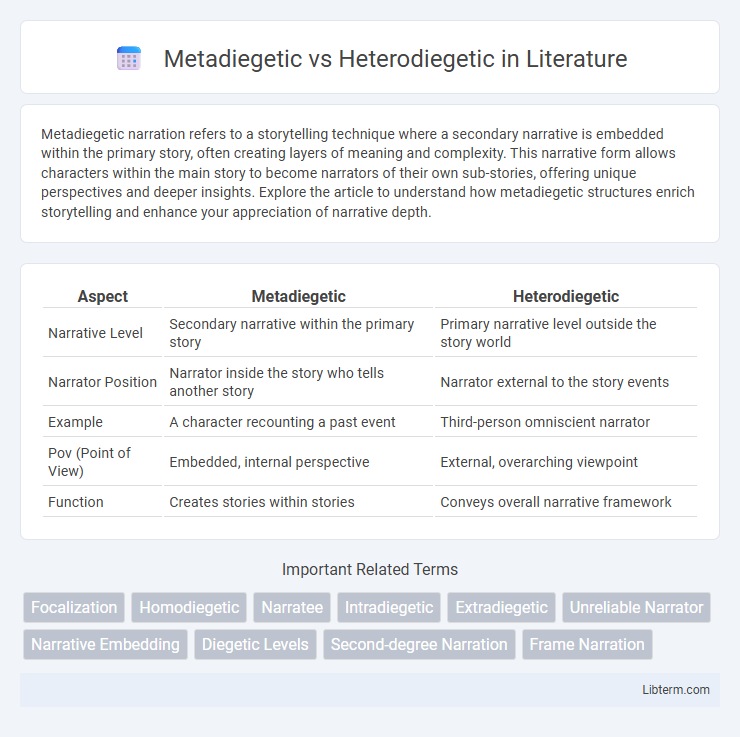Metadiegetic narration refers to a storytelling technique where a secondary narrative is embedded within the primary story, often creating layers of meaning and complexity. This narrative form allows characters within the main story to become narrators of their own sub-stories, offering unique perspectives and deeper insights. Explore the article to understand how metadiegetic structures enrich storytelling and enhance your appreciation of narrative depth.
Table of Comparison
| Aspect | Metadiegetic | Heterodiegetic |
|---|---|---|
| Narrative Level | Secondary narrative within the primary story | Primary narrative level outside the story world |
| Narrator Position | Narrator inside the story who tells another story | Narrator external to the story events |
| Example | A character recounting a past event | Third-person omniscient narrator |
| Pov (Point of View) | Embedded, internal perspective | External, overarching viewpoint |
| Function | Creates stories within stories | Conveys overall narrative framework |
Introduction to Narrative Perspectives
Metadiegetic narrative perspective occurs when a story is embedded within another story, with the narrator existing inside the primary diegesis, offering a layered point of view. Heterodiegetic narration features a narrator who is outside the story world, providing an external, often omniscient perspective on the characters and events. Understanding these narrative perspectives enhances the analysis of storytelling techniques and the relationship between narrator and narrative levels.
Defining Metadiegetic Narration
Metadiegetic narration occurs when a story is told within another story, where a character inside the primary narrative assumes the role of narrator, creating a secondary narrative layer. This contrasts with heterodiegetic narration, where an external narrator recounts the events without participating in the story. In literary theory, metadiegetic narration is crucial for exploring complex narrative structures and unreliable storytelling.
Understanding Heterodiegetic Narration
Heterodiegetic narration occurs when the narrator exists outside the story's fictional world, presenting events without being a character within the narrative. This external viewpoint allows for an omniscient or limited perspective, giving readers access to information beyond the characters' knowledge. Understanding heterodiegetic narration is essential to analyzing how narrative distance shapes the reader's interpretation and emotional engagement with the text.
Key Distinctions: Metadiegetic vs Heterodiegetic
Metadiegetic narrators exist within a story embedded in the primary narrative, often recounting events that occur inside the main tale's universe, while heterodiegetic narrators operate outside the story world, offering an external perspective. Key distinctions include the narrator's position relative to the story and the level of narrative involvement; metadiegetic narrators typically have insider access to characters and events, whereas heterodiegetic narrators maintain an observer's stance. This difference influences narrative reliability and focalization, affecting how audiences interpret the story's truth and depth.
Narrative Layers in Fictional Worlds
Metadiegetic narration occurs when a story is told within another story, creating embedded narrative layers that deepen the fictional world's complexity. Heterodiegetic narrators exist outside the story world they describe, offering an external perspective that can provide comprehensive insight or commentary. Understanding these narrative layers enhances the analysis of fiction by revealing how storytellers manipulate perspective and reality within their texts.
Examples of Metadiegetic Narration in Literature
Metadiegetic narration occurs when a story is told within another story, with the narrator existing inside the primary narrative world, such as the narration of the Janitor in "One Thousand and One Nights." Franz Kafka's "The Metamorphosis" features metadiegetic elements where Gregor Samsa's transformation is recounted through layers of subjective experience. Similarly, Laurence Sterne's "Tristram Shandy" plays with metadiegetic narration as the narrator repeatedly digresses to recount prior tales embedded within the central narrative.
Heterodiegetic Narrators: Classic Instances
Heterodiegetic narrators exist outside the story world, offering an external perspective with no participation in the events narrated. Classic examples include the omniscient narrator in Charles Dickens' "Great Expectations" and the detached narrator in Jane Austen's "Pride and Prejudice," who provide comprehensive, all-knowing insights into characters and plot. These narrators maintain objectivity, controlling the narrative flow and often revealing information beyond the scope of any single character's knowledge.
Functions and Effects in Storytelling
Metadiegetic narrators function within a secondary narrative layer, offering insights or commentary that deepen plot complexity and character psychology, enriching the reader's understanding through nested storytelling. Heterodiegetic narrators exist outside the story world, providing an authoritative, comprehensive viewpoint that controls information flow and shapes the narrative's reliability and objectivity. The contrasting effects of metadiegetic and heterodiegetic narration impact narrative engagement by balancing subjective immersion with external perspective, influencing emotional resonance and thematic interpretation.
Challenges in Analyzing Narrative Levels
Analyzing narrative levels in metadiegetic and heterodiegetic contexts presents challenges due to the complexity of distinguishing between embedded story layers and the primary narrative framework. Identifying the point of view and the narrator's reliability becomes intricate when shifting between metadiegetic narrators within a story and heterodiegetic narrators external to it. This layered narrative structure complicates the interpretation of temporality, focalization, and narrative authority, demanding rigorous theoretical frameworks for accurate analysis.
Conclusion: Narrative Perspective and Reader Engagement
Metadiegetic and heterodiegetic narrators influence narrative perspective by positioning the reader either within a nested story or outside the primary narrative world, shaping engagement through varied degrees of intimacy and reliability. Metadiegetic narration immerses readers deeper by embedding stories within stories, creating layers that prompt critical reflection on the narrative's authenticity. Heterodiegetic narrators maintain distance, offering a broader, more objective viewpoint that encourages readers to interpret events from an external perspective, balancing emotional involvement with analytical observation.
Metadiegetic Infographic

 libterm.com
libterm.com